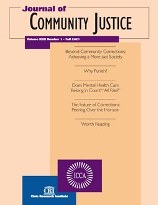A Day in the Life of a Day Reporting Center: Needs and Challenges of Clients Entering and Exiting
Author: Elaine Gunnison.; Jacqueline B. Helfgott.
Source: Volume 25, Number 04, Summer 2016 , pp.5-14(10)

< previous article |next article > |return to table of contents
Abstract:
During the 1980s, intermediate sanctions were implemented in corrections as a method of alleviating overcrowding in jails and prisons. One such intermediate sanction, the day reporting center (DRC) became a widely used sentencing option in many jurisdictions. Although researchers have examined features of DRCs—for example, recidivism rates and cost relative to incarceration—evaluation studies on the effectiveness of DRCs are scarce. The scant empirical literature has made it difficult for existing DRCs to provide evidence to policymakers that these programs are worth continued funding. This article reports on a study of the Community Center for Alternative Programs (CCAP), a DRC program in Seattle that provides treatment and education programs and services for adults. The study explored the needs of CCAP clients and programmatic experiences. Results revealed that clients have a wide range of needs at intake and the ranking of the importance of these needs had some similarities and differences between gender and race. Overall, clients had positive programming experiences, but, despite programming, clients often still have critical needs that must be met in order to foster reentry success.Keywords: Day reporting center (DRC), intermediate sanctions, Community Center for Alternative Programs (CCAP), offender needs, recidivism
Affiliations:
1: Seattle University; 2: Seattle University.